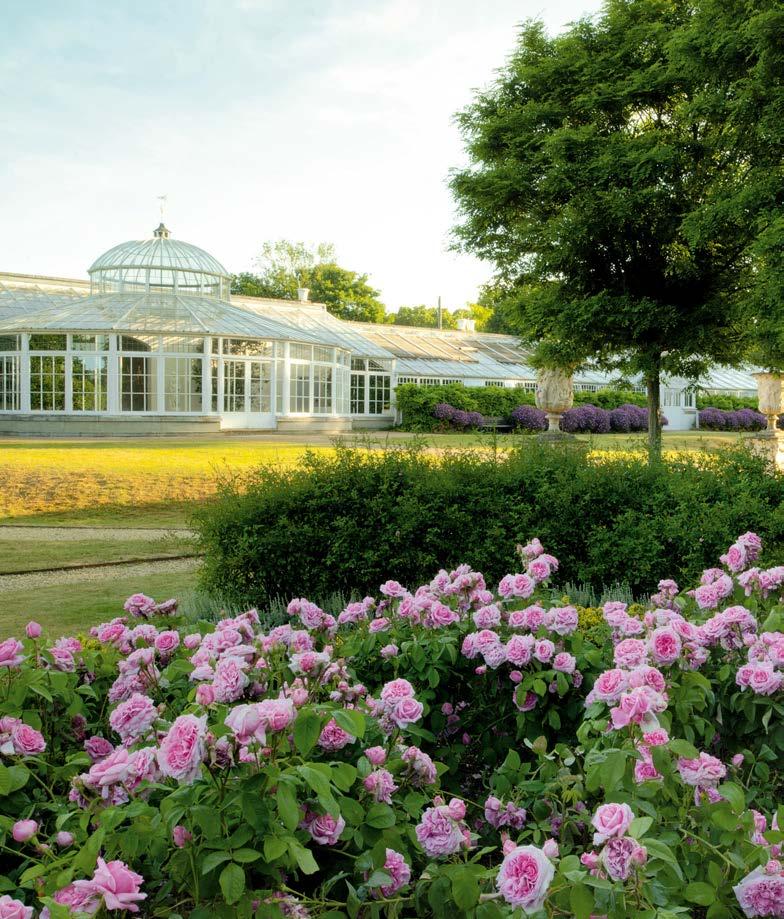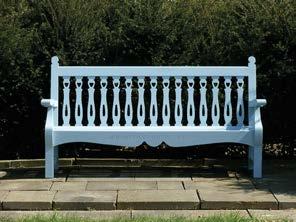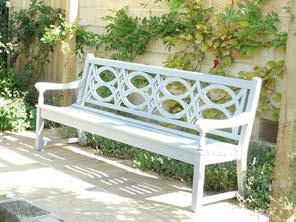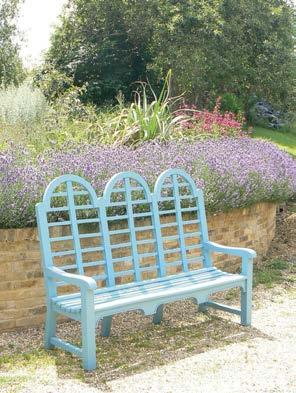
8 minute read
London Gardens Visit some of London’s
As the summer solstice draws close, with warmer and brighter days beckoning, those living in the capital might be tempted to leave the city in search of June’s colourful floral offerings. Yet across London there are numerous exquisite gardens to be discovered, perfect for days out as part of a staycation or even a vacation.
Above Fenton House in Hampstead, which is cared for by the National Trust, showcases an incredible range of horticultural styles.
North London
Hidden away on the leafy edges of Enfield in Greater London is Forty Hall, a grand Jacobean manor house that was built in 1632 by Sir Nicholas Rainton on the site of the former Elsyng Palace. The grounds of the estate cover 273 acres, with landscaping and planting styles from across the past four centuries. The Walled Kitchen Garden hosts ornamental rose beds, while the landscape is dominated by the incredible form of one of the oldest surviving Cedar of Lebanon trees in the country, believed to have been planted by London botanist Dr Robert



Above Myddelton House Uvedale in the middle of in Enfield, the former the 16th century. This home of the great plantsman, E.A. Bowles. year, on 22 August, Left The greenhouse at Forty Hall hosts its Myddelton House, with ninth year of Music its wonderful collection on The Lawn, with of cacti and succulents. Below Forty Hall, a profits going towards Grade I-listed Jacobean the conservation of manor house in Enfield. the Forty Hall Estate. Also part of the estate is Forty Hall Farm, which is home to London’s only organic commercial vineyard (fortyhallestate.co.uk).
A stone’s throw from Forty Hall is Myddelton House Gardens, the family residence of self-taught 20th-century horticulturist Edward August Bowles. The gardens are set across eight glorious acres, and the visitor centre tells the remarkable story of how Bowles transformed the gardens during his lifetime, earning the title of ‘The Crocus King’ along the way. His influence can be found throughout the grounds, especially in The Alpine Meadow, which was inspired by his travels to the Pyrenees. In spring the meadow is covered by a mass of crocuses, followed by a sheet of blue geraniums in summer. With upcoming theatrical productions of Alice in Wonderland on 17 July, Jane Eyre on 31 July and Robin Hood on 23 August, and a chance to unwind with blankets and picnics on the Bowling Green Lawn for Elegant Strings, an all-female quartet, on 4 September, there is ample opportunity to enjoy Myddelton this summer. (visitleevalley.org.uk).
For a combined day out, the National Trust’s Fenton House on genteel Hampstead Grove is located within easy walking distance of Hampstead Heath. By June, the rose garden will have come into full bloom, filling the air with sweet, delicate scents.


The cottage-style garden is filled with roses, foxgloves, phlox, and poppies, creating a wonderful floral display. Ensuring that no colour is left out, alliums, iris and blowsy pink peonies provide a more subtle colour palette elsewhere. The terrace at Fenton House is surrounded by a range of climbing and rambling roses, including the ‘Kiftsgate’ rose, head gardener Andrew Darragh’s personal favourite. In late summer, popular dahlias ‘David Howard’ and ‘Bishop of Llandaff’ are at their colourful peak (nationaltrust.org.uk).
Top left Hydrangea ‘Annabelle’ in a shady, tranquil corner of the Inner Temple Garden. Top right The secluded, peaceful gardens at The Charterhouse. Above The Inner Temple has become known for its flamboyant border displays in summer.

The City
A secret London oasis, the Inner Temple Garden, overlooks the River Thames. The garden predates the founding of the Inn and is referred to in medieval records that describe orchards and roses, with archives recording the first gardener to have been appointed here in 1307. It is also known as the setting for Part I of Shakespeare’s historical trilogy Henry VI, where it serves as the backdrop for the meeting that leads to the War of the Roses. The garden is renowned for its herbaceous borders, mature trees, container displays and meadows. Intimate seating with views out to London’s iconic landmarks make it a perfect spot to while away a summer afternoon. The garden usually opens to the public on weekdays from 12.30-3pm and for events such as the Chelsea Fringe Festival and Open Garden Squares weekend (innertemple.org.uk).
In Clerkenwell, The Charterhouse reopens on 1 June, and tours will run from Tuesday to Saturday. Designed in an English country garden style, these gardens have been in existence for 650 years and were previously part of a seven-acre estate that used to be a historic monastery and Tudor palace. The Charterhouse is now an almshouse, and its serene and tranquil gardens are tended by head gardener Kate Robinson and the Brothers (the name given to residents). According to Kate, the latest additions to the garden’s planting include Lobelia tupa and echiums (thecharterhouse.org).
West & South-West London


Wander through classical landscaping and wilderness areas at Chiswick House and Gardens, the birthplace of the English Landscape Movement. Meandering woodland paths lead to several 18th-century follies designed by Lord Burlington and William Kent. From June to October, meadows introduced in front of the house to encourage pollinators will be in flower. Meanwhile, The Rosary features an extensive collection of pre-1850 rose varieties, while behind the walls of the awardwinning Kitchen Garden, visitors will find 280 fruit trees and 170 varieties of vegetables. Divided into flower, vegetable, nuttery and community quarters, the kitchen garden provides visitors with a chance to see the result of ‘no dig’ techniques. A variety of upcoming events include Giffords Circus from 24 June to 11 July and a performance of Macbeth on 7 July (chiswickhouseandgardens.org.uk).
Set on the edge of the Thames, the Chelsea Physic Garden is London’s oldest botanic garden. Founded in 1673 by The Worshipful Society of Apothecaries of London for their apprentices to study medicinal plants, it has since developed into one of the most respected botanic gardens in Europe. The garden’s unique collection includes around 5,000 edible, medicinal and useful plants for the curious to discover. On 3 June you can enjoy a Behind the Scenes Tour with head gardener Nell Jones, on 14 June you can spend a day learning about The History of Chelsea Physic Garden in 10 Objects, and there are a series of ‘Living Medicine’ events running across the summer (chelseaphysic garden.co.uk).
In Twickenham, the gardens of Strawberry Hill House, embrace the vision of their creator Horace Walpole. Inspired by Chiswick House’s William Kent, Walpole set about creating a romantic garden to compliment his creation of a Gothic Revival house in 1747. Centuries later, the grounds thrive as an oasis for wildlife and visitors. Seasonal highlights include Horace Walpole’s favourite time of year, ‘Lilactide’, when he was transported to the beauty of the country and its ‘perfumed air’. The summer brings Historic Garden Tours on Tuesdays, Wednesdays and Thursdays, which explore how the site evolved, simultaneously as a sanctuary for nature and as a place for high society from the 18th century to the present day (strawberryhillhouse.org.uk).
Ham House in the charming settlement of Ham, near Richmond upon Thames, is a sterling example of Stuart architecture with a fascinating history. What was a gift from King Charles I to courtier William Murray, is now a gift to those who visit through the National Trust. Ham House’s garden rises to the occasion and matches the building’s grand architectural exterior. Over 1,200 lavender plants flower in the lavender and box parterre, while in June the two-acre kitchen garden produces a bountiful harvest of heritage crops and edible flowers (nationaltrust.org.uk). n
Top Rosa ‘Jacques Cartier’ in front of the famous greenhouse at Chiswick House. Above right Tucked away on the banks of the Thames, the Chelsea Physic Garden is a trove of unusual plants. Above left Striking architecture at Strawberry Hill House.





















In the Fold
From her rural studio in Powys, Kate Kato creates intricate, three-dimensional, paper models inspired by the natural world
PHOTOGRAPHS BRENT DARBY

Kate Kato’s threedimensional paper sculptures of plants are often displayed on wooden plinths.










